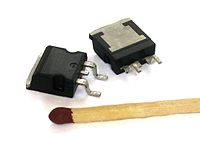
Photo from wikipedia
Abstract In this study, hydroxyapatite-containing coatings were prepared by microarc oxidation on AZ31 magnesium alloy surface to improve its biodegradation performance. Five applied voltages were chosen to prepare the MAO… Click to show full abstract
Abstract In this study, hydroxyapatite-containing coatings were prepared by microarc oxidation on AZ31 magnesium alloy surface to improve its biodegradation performance. Five applied voltages were chosen to prepare the MAO coatings. The results demonstrate that the number of micropores in the films increases but their dimensions decrease after higher voltage is applied. As the surface roughness of the MAO coatings increases with the applied voltage, the wettability of the coatings improves continuously. The MAO coatings were mainly composed of magnesium oxide (MgO) and hydroxyapatite. The amount of hydroxyapatite phase increased with increasing voltage that was applied. The bonding strength became slightly weaker after a higher voltage was applied. But the bonding strengths of all the coatings were consistently higher than 37 MPa, which met the requirement of implant biomaterials. All coatings exhibited higher corrosion resistances and lower hydrogen evolution rate than the bare AZ31 Mg substrate, implying that the degradation rate of the AZ31 Mg alloy was enhanced by the hydroxyapatite-containing coatings. The results indicate that the present treatment of applying hydroxyapatite-containing coatings is a promising technique for the degradable Mg-based biomaterials for orthopedic applications.
Journal Title: Applied Surface Science
Year Published: 2017
Link to full text (if available)
Share on Social Media: Sign Up to like & get
recommendations!